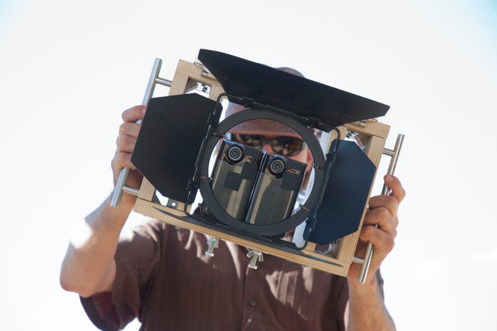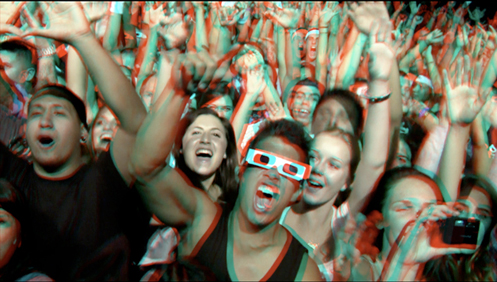How Erik Spicard shot and edited Pepper's latest 3D concert video for under $5K

Shooting Style
Spicard, who shot his first concert video for the Stone Temple Pilots right out of high school, has also been gathering a unique set of techniques during his more recent work as a 3D stereographer, director and producer. He has worked with 3ality on 3D sports shows for SkyTV where he says he literally kludged his Avid editing workflow onto a Quantel Pablo in order to keep it on time and on budget. His video “Native Son,” which also happened to be the first 3D video shown during New York Fashion Week last winter, went on to win a first for Excellence in Visual Arts at the Invazion 3-D Film Fest this year. For Kelly Rowland’s latest video, he and cinematographer Marco Mazzei shot with two SI-2K minis and a Quasar rig. Because this gig called for exponentially more affordable gear than that high-concept production, Spicard built his own rigs from scratch.

Spicard’s “Shoebox” rig made with two mini Kodak Zi8 1080p HD cameras.
(Photo by Oli Hecks)
Spicard put together his first wireless rig, which he calls the “Shoebox,” earlier this year with the help of fellow filmmaker and craftsman Cliff Cruz. They used two mini Kodak Zi8 1080p HD cameras, which look and shoot very much like Flip cameras, in 1080p at 30 fps. “We needed it out of pure necessity and there were no other wireless HD 3D cameras on the market yet. Necessity drove invention and this rig had the unique bonus of being able to actually see the 3D result while filming by merging your eyes in parallel on the side by side viewfinders,” he says. “You can get a realtime, intuitive capture and feel of the 3D space as you shoot, which is essential. By using my custom stereo rigs I was able to get up close on stage and get the shots I needed, all on a very tight budget.”
Spicard first used the Shoebox to capture the Metal Mulisha X-games freestyle motocross team. “We shot them doing acrobatic flips through the air,” he says. “It turned out spectacular!” For the Pepper project, he used it in conjunction with another larger rig featuring two pro HD cameras.
Though he’s well aware that even his pro HD rig is not equal in quality to the SI-2K, Sony or RED cameras used on shoots with budgets that start at $50,000 and ramp up steadily from there, he says that the 1920×1080 HD footage his team got for the Pepper project holds up perfectly well for Web and mobile distribution, which was the primary aim for the band. “I just heard that LG and others are coming out with stereo cell phones early next year, so the 3D devices are multiplying,” he says. “Pepper wants its fans to be able to see this not just at a performance, but anywhere and anytime they want to.”

Due to the size of his rig, Spicard could move in close to the band during shooting.
Making it Work in Post
Spicard’s playful edits of the band, onstage and off, with multiple crowd shots (both during the performance and outside the venue) helps keep the tone as light and as kinetic as the track it’s set to. This is 3D for the fun of it, but also with the goal of pulling the viewer, head first, into Pepper’s zany but slick live performance. The band, originally from Kailua-Kona, Hawaii, is known and loved by fans for their slightly warped vision of the beachside lifestyle, which it both pokes fun at and celebrates in the same breath. In the “Drunk Girl” video, the song’s uptempo reggae beats punctuate Spicard’s cuts and the performance’s convivial scene, ensuring that Pepper’s usual tongue-in-cheek take on an otherwise touchy topic is all in good fun. If you’re a Pepper fan you’re already in on the joke, so why not jump in and start dancing?

Spicard desaturated the reds during his edit to preserve the red-and-blue anaglyph.

The audience features prominently in the video’s give-and-take between the band
and its fans.
During his edit, Spicard says he was going for the lenticular postcard effect by scrubbing over the crowd, speeding up the footage and creating a loop that conveyed both the energy of the band and its fans. “Once I saw that we’d gotten a few great moments with the audience, where the 3D is popping and the mood is high, I knew I had to make them prominent. I decided to maximize them by looping them in a way that reminded me of that retro 3D style.”
Spicard cut the video in Final Cut on a laptop, using a bunch of his own plug-ins, then conformed in Final Cut on his eight-core Mac workstation. “I got interested as far back as ’91 in the Magic Eye books and Random Dot Stereograms, when I figured out a way to use a computer platform to create my own stereoscopic content viewable in the parallel viewing method, essentially by merging my eyes together, and I created a paint tool that let me pull the left and right eye onto a z-axis plane so I could photographs or fine art in that 3D space. Now that the technology has caught up, I can do it all digitally and the masses can see it. Cutting on the z-axis is the exciting part of it all, when you can place cuts and see if the 3D goes in front or behind screen. You learn really quickly where cuts work and where they don’t.”
The low lights and spots, typical of most rock shows, were a mixed blessing, says Spicard. “It was a challenge to the extent of when there was minimal light, we were forced to gain up on the cameras, which brings a noisier look overall to the video. But in this case, since I was running and gunning for a rock band during one of its shows, I was able to pull the best of the shots I could and finesse the others in post.” The audience shots, which received periodic spots, jump out in the video with detail. “If I had had more creative control over the lights, we could have done a lot more, of course,” he adds. “But for a guerilla-style shoot, I think we did a great job capturing the scene.”
The band debuted the anaglyph video during the tour in mid-November at LA’s Club Nokia, where it played on nearly two dozen 2D 65-inch and 46-inch Nokia monitors throughout the venue. “I was happily surprised to see how well the video looked blown up on the screens,” says Spicard. “The crowd loved it. Because of the digital anaglyphic mastering that I did, it really helped it sing. If you don’t master anaglyph properly, any blues or reds in your video will cancel the 3D effect. So I mastered the color for the anaglyph so the 3D pops. I desaturated the reds, which end up looking more like a soft purple or gray.”
For those without 3D laptops or TVs, the band is offering its fans free red and blue anaglyph glasses either on its Web site at www.pepperlive.com or at the this direct link.
Watch a sneak peek of the video here:
The full video will be posted on the Web via various partners in the coming weeks. Spicard has just finished filming live concert footage of the band Fishbone and a separate live performance of music producer Damon Elliot (Destiny’s Child, Beyonce, P!nk, Gwen Stefani). To follow Spicard and his 3D work, check out his Web site, www.erikspicard.com.
Sections: Creativity Technology
Topics: Feature Project/Case study
Did you enjoy this article? Sign up to receive the StudioDaily Fix eletter containing the latest stories, including news, videos, interviews, reviews and more.